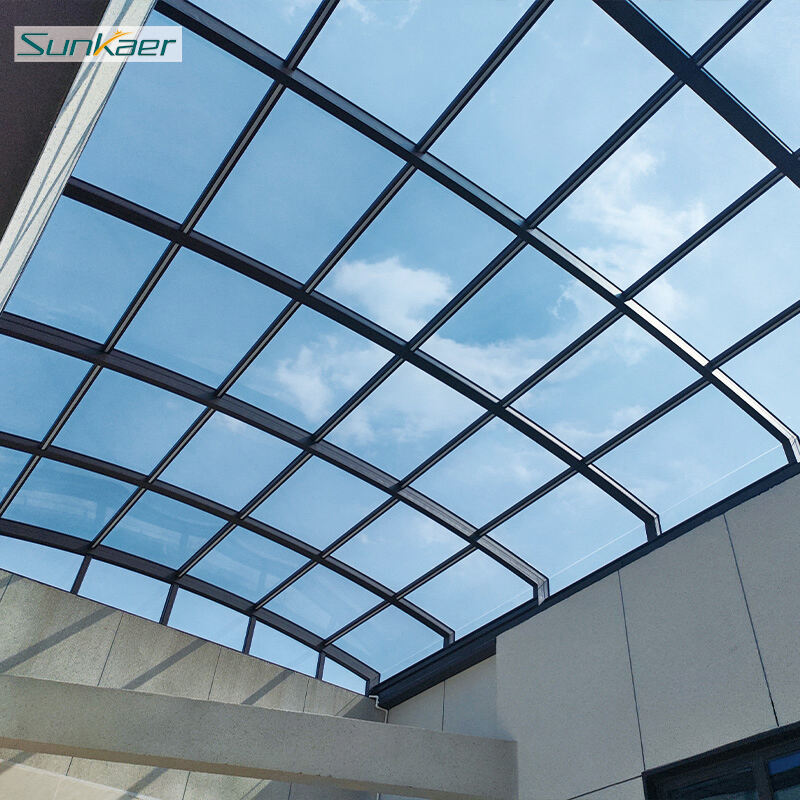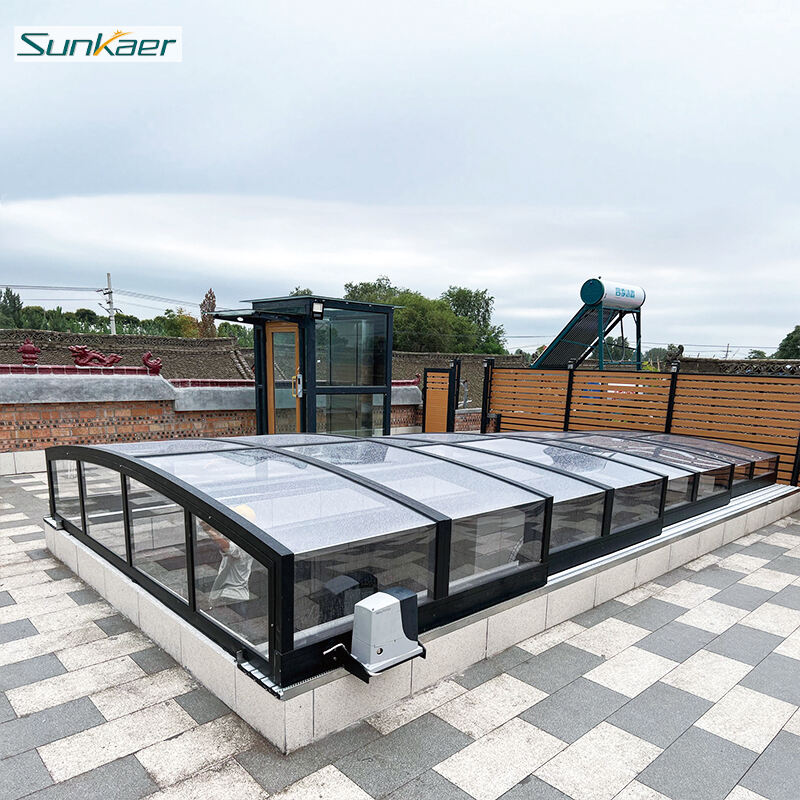A practical blueprint for transforming outdoor spaces
Polycarbonate Retractable Roofs bring together durability, light control, and flexibility to create outdoor living and commercial spaces that work in every season. These systems allow homeowners, restaurateurs, hotel operators, and facilities managers to switch quickly between open-air enjoyment and sheltered comfort. Because polycarbonate panels are lightweight, impact resistant, and transmit natural daylight while blocking harmful UV, Polycarbonate Retractable Roofs keep spaces bright and protected without needing heavy glass or complex framing. When combined with motorized operation, smart sensors, and good detailing, a Polycarbonate Retractable Roof becomes a near-seamless extension of the indoor environment—expanding usable space, reducing weather-related downtime, and enhancing guest comfort.
Material strengths and performance of polycarbonate panels
Exceptional impact resistance and long service life
Polycarbonate is engineered to withstand impacts and thermal stress far better than glass. Its toughness reduces breakage risk from hail, falling branches, or accidental hits, making Polycarbonate Retractable Roofs especially suitable where safety and durability matter. The material’s high tensile strength and dimensional stability keep the roof system functioning reliably through temperature swings and repeated opening cycles.
High light transmission and controlled solar performance
Modern polycarbonate panels offer strong light transmission similar to glass while allowing designers to tailor solar gain with tints, multiwall insulation, or UV-blocking layers. That balance gives outdoor spaces the daylight benefits of skylights without the glare or overheating that can make patios uncomfortable. Multiwall options also add insulation value, improving thermal performance when the roof is closed.
Why retractable systems beat fixed roofs for many spaces
Flexibility to match weather and mood
A retractable system lets people enjoy open sky on calm days and instant shelter when weather turns. For restaurants, hotels, and private terraces, that flexibility translates into fewer cancellations, more comfortable customers, and longer seasons of use. Retractable roofs change the economics of outdoor space by turning unusable areas into reliable, sellable square footage.
Protection for furniture, fixtures, and finishes
When closed, a Polycarbonate Retractable Roof protects outdoor furniture, lighting, and finish materials from UV, rain and wind-driven debris. Over time this protection reduces replacement cycles and lowers maintenance budgets, improving both aesthetics and total cost of ownership.
System types and how they suit specific uses
Sliding-panel retractable roofs for large spans
Sliding-panel systems with polycarbonate infill work well for wide patios, pool enclosures, and atriums. The panels can be motorized for smooth operation, and multi-track systems allow for partial opening patterns that fine-tune airflow and daylight. This type is ideal where uninterrupted daylight and flexible ventilation are priorities.
Folding or louver-based retractable roofs for precise control
Some retractable roofs use folding panels or adjustable louvers to balance shading and air movement. When polycarbonate is used as a durable, lightweight slat or panel material, the system gains resilience and faster actuation—useful for hospitality spaces that need to reconfigure quickly between service periods.

Design and installation best practices
Structural support and wind load considerations
Although polycarbonate is lightweight, the retractable assembly and wind loads require a robust support structure and careful anchoring. Accurate wind analysis, proper sealing, and connection detailing keep the system watertight and reduce rattles or operational snags in windy conditions.
Thermal breaks, condensation control, and drainage detailing
Good detailing prevents common issues like thermal bridging and condensate drip. Use thermal breaks in framing, sloped rebates for drainage, and integrated gutters to route water away from seating and façade junctions. Proper seals and weep paths are essential for long-term performance.
Motorization, sensors, and control integration
Automated motors with weather sensors (rain, high wind) protect the investment by closing the roof when conditions demand it. Integration with building controls or a simple app makes operation straightforward for staff or homeowners, and pre-set scenes (open, half-open, closed) speed transitions during service.
Thermal comfort, daylighting, and energy implications
Natural light reduces daytime electric loads
Polycarbonate Retractable Roofs let daylight flood covered areas, lowering daytime lighting demand. For commercial operators this can mean measurable energy savings and a more appealing ambiance for diners and guests during the day. Selecting the right translucency and coating balances light with thermal comfort.
Insulation choices for seasonal use
Multiwall polycarbonate adds insulation value compared with single-sheet options, improving retained heat when roofs are closed in cooler months. Combining multiwall panels with night controls and insulated peripheral closures reduces heating loads and extends usable season without large energy penalties.
Acoustic and visual comfort
Sound attenuation and noise control strategies
Polycarbonate panels can help reduce rain noise and dampen street sounds when paired with proper framing, seals, and acoustic liners. For restaurants and rooftop bars, lowering intrusive noise improves conversation quality and the overall guest experience.
Managing glare and view control
Tinted or diffusing polycarbonate prevents harsh glare while preserving views to the sky. Motorized shading and integrated blinds give operators additional control for evening events and projection uses.
Maintenance, durability, and lifecycle planning
Expected maintenance routines
Polycarbonate Retractable Roofs require regular track cleaning, seal inspection, and motor servicing. Panels resist UV degradation and impacts but still benefit from periodic washing and inspection for seal wear. A preventive maintenance schedule minimizes operational interruptions and extends warranty periods.
Repairability and component replacement
Because polycarbonate is modular, damaged panels are often replaceable without removing entire spans. Retractable systems designed with accessible panels and standardized fasteners reduce repair times and service costs.
Applications that gain most from polycarbonate retractable roofs
Restaurants and bars seeking year-round outdoor seating
Polycarbonate Retractable Roofs enable patios to work in rain, wind, or sun—allowing restaurateurs to sell outdoor ambience all year. The systems reduce cancellations and increase covers, particularly in shoulder seasons where weather unpredictability used to limit revenue.
Hotels, resorts, and pool enclosures that need weather assurance
Hotels use retractable systems to turn pool decks and outdoor restaurants into reliable amenities that operate regardless of weather. Polycarbonate offers lighter weight than glass, reducing structural costs while providing strong UV protection for guests and poolside furniture.
Retail arcades, greenhouses, and mixed-use public spaces
From covered shopping promenades to climate-controlled atriums, Polycarbonate Retractable Roofs offer flexible daylighting and weather protection, improving shopper comfort and enabling events that otherwise would be rain-checked.
Sustainability and environmental considerations
Long-lived materials and recyclability
Polycarbonate is durable and, depending on the product, can be recycled at end of life. Choosing panels with UV-stable coatings and good warranties ensures long service life and lowers the embodied carbon over replacement cycles.
Energy efficiency and carbon impact
By enabling passive daylighting and reducing HVAC runtime through improved insulation choices, Polycarbonate Retractable Roofs help lower operational carbon footprints—particularly when paired with renewable energy for motors and lighting.
Cost considerations and value modeling
Upfront costs versus revenue upside
Retractable systems with polycarbonate panels are a capital investment, but the increased usable area, reduced weather-related cancellations, and improved guest experience often shorten payback periods for commercial operators. Modeling increased covers, premium event bookings, and energy savings clarifies ROI.
Lifecycle costing and maintenance budgeting
Include scheduled motor servicing, track cleaning, and occasional panel replacement in lifecycle budgets. The lower weight and impact resistance of polycarbonate typically reduce repair and replacement costs compared with glass systems.
Choosing the right polycarbonate and supplier
Panel types and coatings to specify
Decide between single-sheet, multiwall, or structured polycarbonate based on insulation needs, light control, and budget. Specify UV-protective coatings on exposed faces and consider anti-scratch layers in high-traffic environments.
Selecting an experienced supplier and installer
Work with suppliers who provide design support, 3D site planning, and regional installation expertise. Professional teams ensure proper wind and snow calculations, code compliance, and post-installation service commitments—critical for long-term reliability.
Case-ready programming and operational tips
Event formats that exploit retractability
Use partial opening positions for dining under the stars while protecting service lanes; close fully for private events or film nights; open partially for ventilation during hot afternoons. Pre-programmed scenes reduce staff workload and help deliver consistent guest experiences.
Staff training and safety protocols
Train staff on manual override procedures, weather sensor alerts, and routine visual checks. Clear safety signage and lock-out procedures during maintenance protect patrons and technicians.
Practical checklist before you order
Site survey and wind analysis
Have the site surveyed for prevailing winds, snow loads, and roof connections. Foundation of the canopy and interface with adjacent facades must be engineered to local conditions.
Mechanical and electrical integration plan
Plan for motor power, control wiring, and rain/wind sensors. Backup manual operation strategies ensure the system is fail-safe during power interruptions.
Maintenance and warranty alignment
Negotiate clear warranty terms that include motors, panels, and seals, and schedule preventive service visits in the contract to protect uptime.
FAQ
How do polycarbonate retractable roofs compare to glass systems
Polycarbonate Retractable Roofs are much lighter and more impact resistant than glass, which reduces structural framing needs and improves safety. They transmit daylight while often costing less to install and maintain, especially in environments prone to hail or impact risks.
Are polycarbonate panels safe in strong winds and storms
When specified and installed correctly with adequate framing, anchoring, and wind seals, Polycarbonate Retractable Roofs perform well in challenging climates. Proper wind-load engineering and weather sensors help ensure resilience and safe operation.
What maintenance do these roofs need and how often
Expect quarterly to biannual maintenance: track cleaning, seal checks, panel wash, and motor inspection. Environments with heavy pollution or salt spray may require more frequent care to prevent rapid seal degradation.
How soon will a retractable roof pay back for a commercial operator
Payback depends on increased covers, seasonal extension, and energy savings. Many restaurants and hotels see material revenue uplift through more reliable outdoor seating and event bookings; modeling local demand and energy prices gives the clearest answer.
Table of Contents
- A practical blueprint for transforming outdoor spaces
- Material strengths and performance of polycarbonate panels
- Why retractable systems beat fixed roofs for many spaces
- System types and how they suit specific uses
- Design and installation best practices
- Thermal comfort, daylighting, and energy implications
- Acoustic and visual comfort
- Maintenance, durability, and lifecycle planning
- Applications that gain most from polycarbonate retractable roofs
- Sustainability and environmental considerations
- Cost considerations and value modeling
- Choosing the right polycarbonate and supplier
- Case-ready programming and operational tips
- Practical checklist before you order
- FAQ

